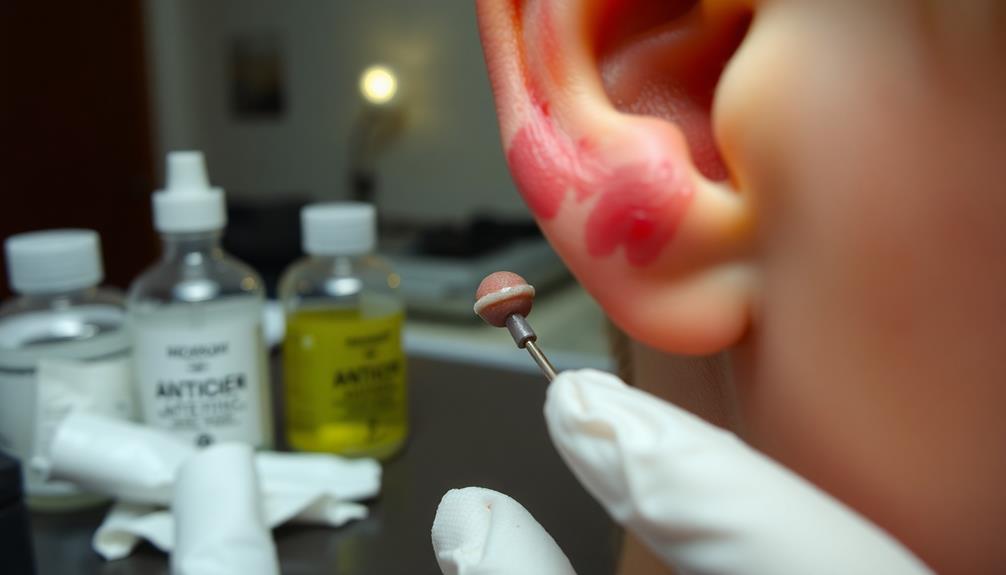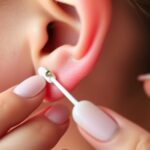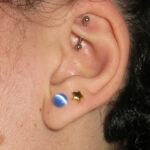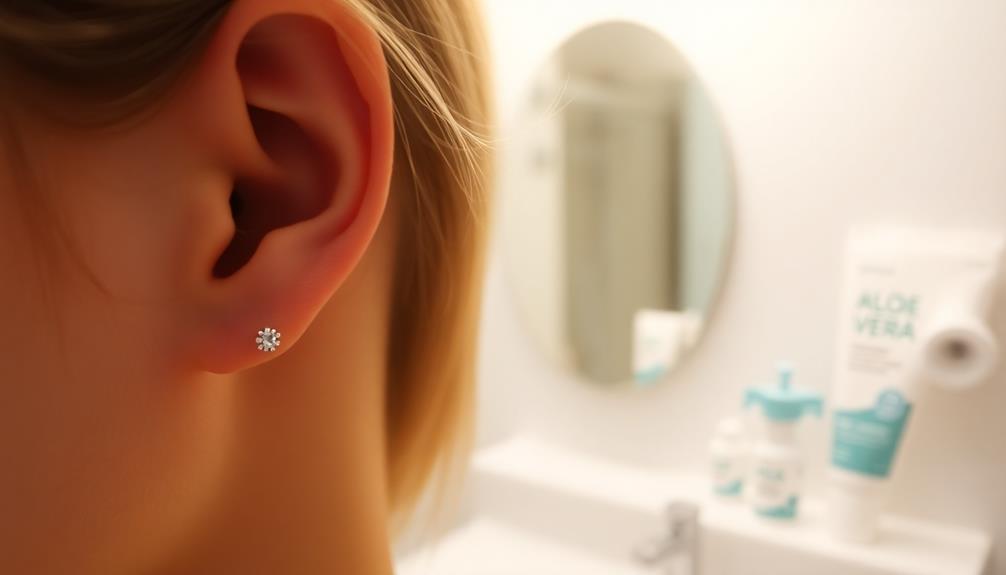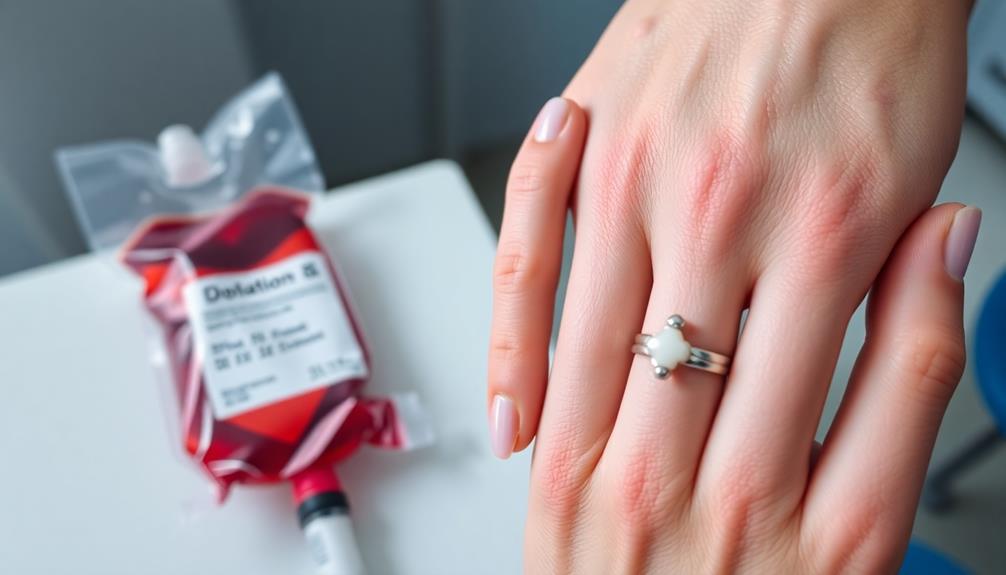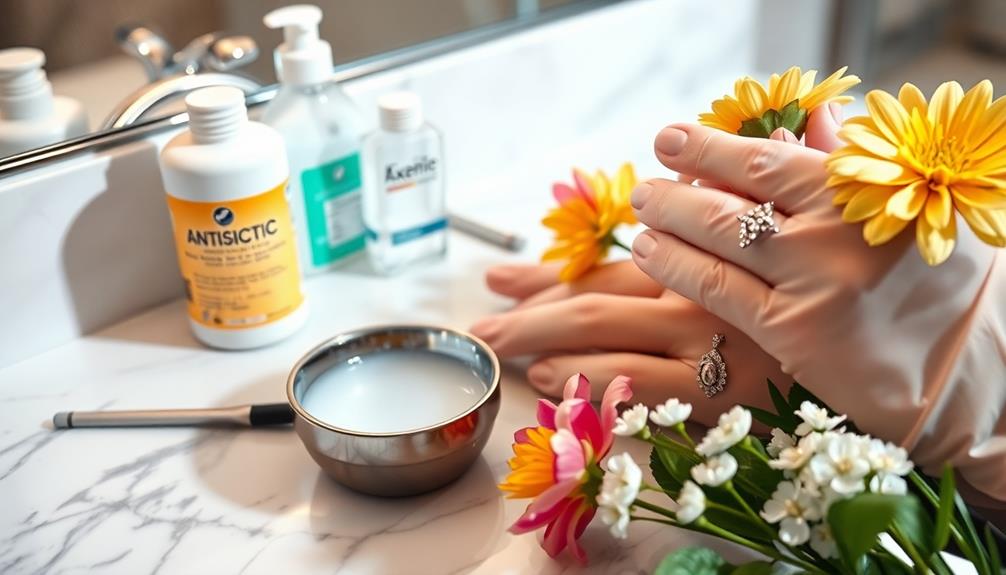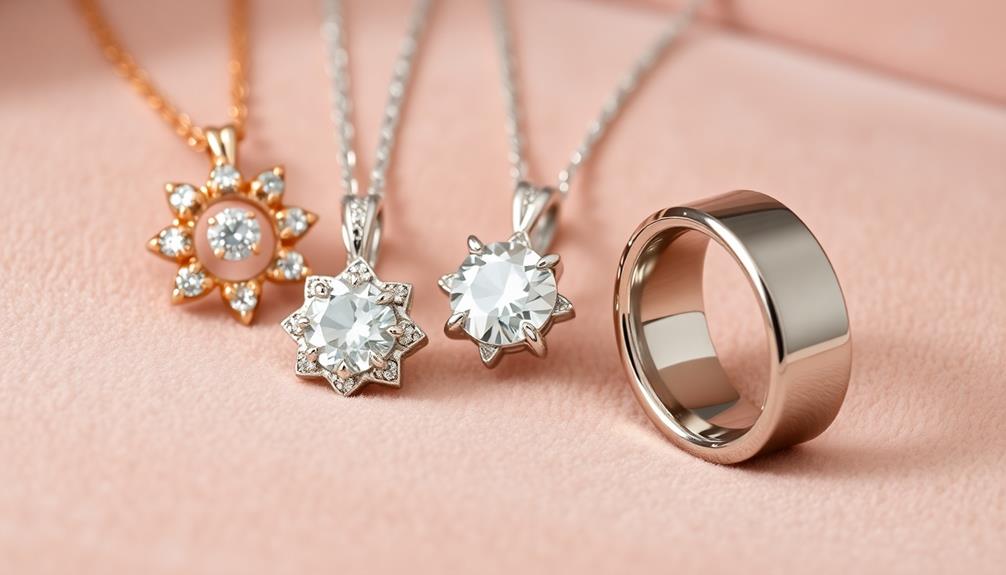To properly clean and care for your new piercings, use a saline solution of 1/8 tsp sea salt in 8 oz warm water. Clean your piercing gently with disposable gauze or cotton pads at least twice daily, and remember to wiggle the jewelry slightly to remove debris. Avoid harsh cleansers with alcohol or perfumes, which can irritate your skin. Keep the area dry to prevent bacteria growth, and limit touching your jewelry. Always watch for signs of infection like redness or abnormal discharge. If you want more tips for ongoing care, there's plenty to explore next.
Key Takeaways
- Clean the piercing twice daily with a saline solution made of 1/8 tsp sea salt in 8 oz warm water.
- Use disposable gauze or cotton pads to gently clean around the jewelry and remove any debris.
- Avoid touching or twisting the jewelry to prevent introducing bacteria and irritation.
- Monitor for signs of infection, such as redness, swelling, or abnormal discharge, and seek medical advice if observed.
- Use high-quality jewelry made from surgical steel, titanium, or gold to minimize irritation and promote healing.
Importance of Aftercare
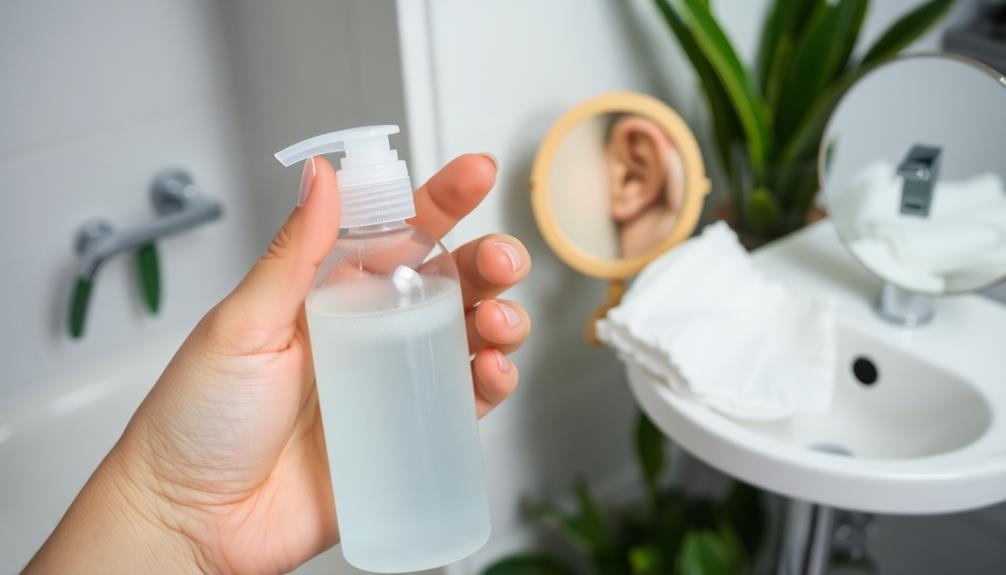
Aftercare is essential for guaranteeing your new piercing heals properly and looks its best. When you don't follow a solid aftercare routine, you risk infection, which can lead to complications and prolong the healing process. Regularly cleaning your piercing helps prevent bacteria from accumulating, supporting ideal healing conditions.
Proper aftercare not only enhances the appearance of your piercing but also reduces the risk of tissue damage. If you neglect this critical step, you may face increased irritation, keloids, or even allergic reactions.
For earlobe piercings, the healing time typically ranges from 1 to 2 months, while cartilage piercings can take 6 months to a year. By adhering to aftercare guidelines, you can greatly shorten this healing time.
Using approved aftercare products and maintaining a clean environment around your piercing is essential. Make sure you take proper safety precautions, like washing your hands before touching your piercing.
This proactive approach will help guarantee a smoother healing process and keep your new piercing looking fantastic. So, don't overlook aftercare—it's a small investment of time that pays off in the long run!
Cleaning Techniques
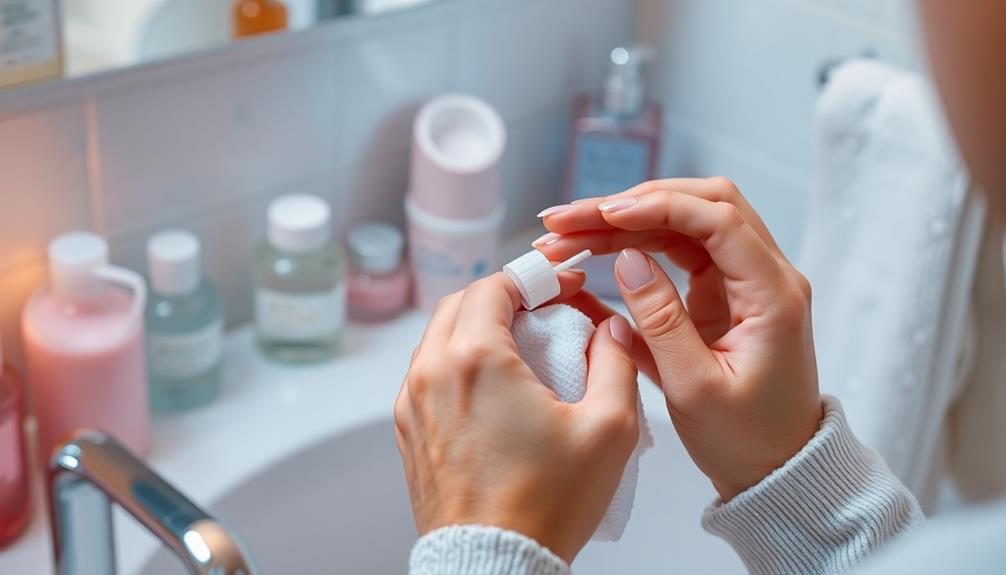
How can you confirm your new piercing stays clean and heals properly? The key is to establish a consistent cleaning routine.
Start by mixing a saline solution using 1/8 tsp of sea salt in 8 oz of warm water. When cleaning your piercing, apply this solution with clean, disposable gauze or cotton pads at least twice daily. Gently wiggle the jewelry during cleaning to make sure the saline penetrates the area, helping to eliminate any debris.
It's essential to avoid harsh cleansers with perfumes or alcohol, as they can irritate your skin and delay healing.
Always wash your hands thoroughly before touching your piercing to further reduce the risk of infection. After cleaning, take care to keep the area dry by gently patting it with a clean towel. Moisture can promote bacterial growth, which could lead to complications.
Signs of Infection
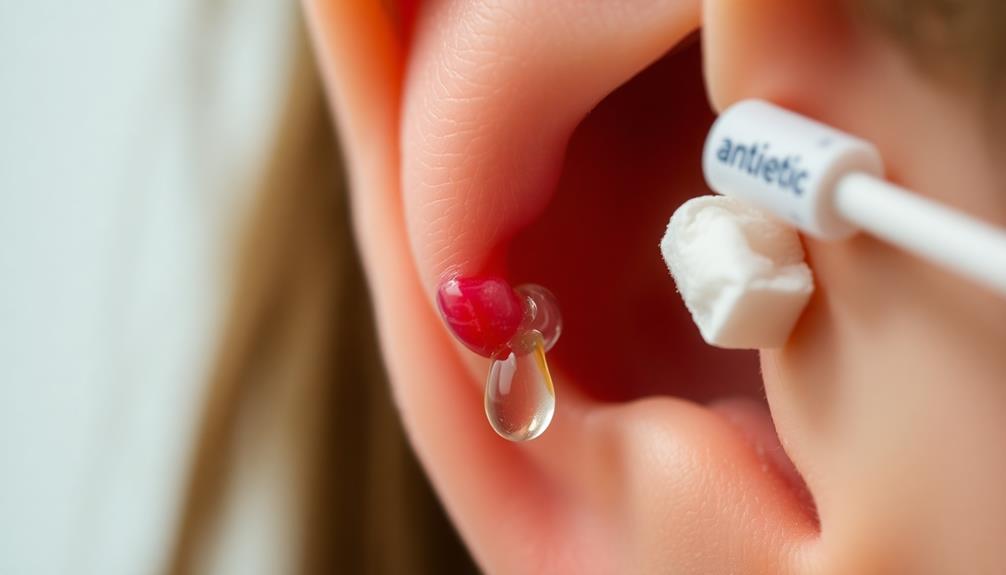
Infection can be a serious concern for new piercings, and recognizing the signs early is vital for a smooth healing process. Pay attention to persistent redness, swelling, or warmth around the pierced area, as these can indicate an inflammatory response.
If you notice any abnormal discharge, particularly yellowish or greenish, this could signal an infection that requires monitoring.
Additionally, if the pain around your piercing worsens or becomes throbbing instead of dull, it's a warning sign that shouldn't be ignored.
Watch for systemic symptoms like fever, fatigue, or chills, as these may indicate a more serious infection needing immediate medical intervention.
If you experience any of these signs of infection, don't hesitate to seek medical advice. It's important to consult a professional piercer or healthcare provider for proper evaluation and treatment, especially if symptoms persist or worsen.
Taking these steps early can help prevent complications and guarantee a healthier healing process for your new piercing. Remember, your body is sending you signals, so listen closely and act accordingly!
Common Mistakes to Avoid

When caring for your new piercing, it's easy to make mistakes that can hinder healing.
You might think cleaning more often or using harsh products will help, but these can actually irritate your skin and slow down the process.
Let's look at the common pitfalls to avoid for a smoother healing experience.
Overcleaning and Irritation
Although it might seem counterintuitive, overcleaning your new piercings can actually do more harm than good. While it's crucial to keep the area clean, excessive cleaning can lead to irritation and dryness, hindering your healing process.
Here are some common mistakes to avoid:
- Cleaning too often: Limit cleaning to no more than twice daily. Overcleaning disrupts the natural healing process.
- Harsh cleansers: Avoid products containing alcohol or peroxide. These can cause additional irritation and dry out the skin.
- Touching or twisting jewelry: Frequent handling can introduce bacteria, leading to inflammation or slow healing times.
- Moisture buildup: Make sure the area stays dry between cleaning sessions to prevent bacterial growth and reduce infection risk.
Remember that scabs are a part of healing. Don't disturb them, as this can lead to bleeding and reopen the wound, complicating your healing process.
Using Harmful Products
Using harmful products can greatly hinder the healing of your new piercings. It's essential to steer clear of alcohol-based solutions and hydrogen peroxide, as these can irritate your skin and delay the healing process.
Instead, focus on gentle cleaning methods that promote a healthy environment for your piercing.
You should also avoid antibacterial soaps with fragrances or harsh chemicals. These can spark allergic reactions and disrupt the natural healing process.
When cleaning your piercing, don't use Q-tips or cotton balls, as they can leave behind fibers, making it easier for infections to develop.
Moreover, skip ointments or creams not specifically designed for piercings—they can trap moisture and bacteria, increasing your risk of infection.
Always wash your hands before you touch your piercing and avoid touching it with unclean hands.
Special Considerations for Oral Piercings

Caring for oral piercings requires special attention to maintain hygiene and promote healing. Since the mouth is a breeding ground for bacteria, you need to be diligent about your cleaning routine. Here are some essential tips to follow:
- Use an antimicrobial mouthwash: Choose an alcohol-free option to prevent irritation and infection. Rinse your mouth 3-4 times daily after meals to help cleanse the area around the piercing.
- Prepare a saltwater solution: Mix 1/4 teaspoon of salt in 8 ounces of warm water. Swish this solution in your mouth 3-4 times daily to aid in the healing process.
- Limit mouthwash use: Avoid excessive rinsing; stick to 4-5 times daily to prevent over-irritation of the piercing site.
- Be cautious with food and drinks: During the initial healing period, steer clear of hot, spicy, or acidic items to minimize discomfort and irritation.
Long-Term Piercing Maintenance
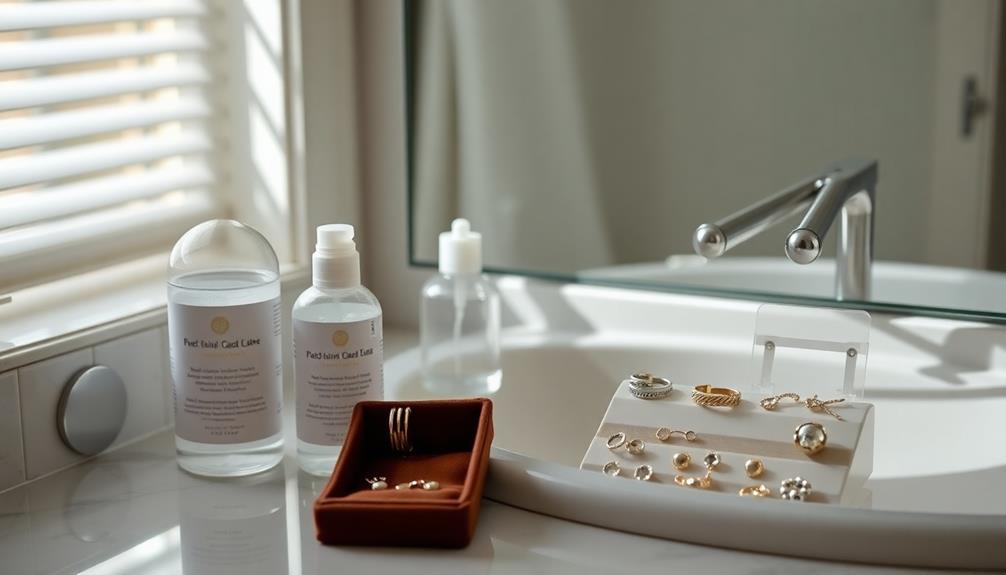
Maintaining your piercings long-term is vital for their health and appearance. After the initial healing period, you should continue to clean your piercings regularly—ideally, wash them once a day to maintain proper hygiene. This consistent care helps prevent infections and keeps your piercings looking fresh.
You'll want to gently apply a saline solution or an aftercare product recommended by your piercer. Doing this twice a day will help keep the area clean without causing irritation. Always monitor your piercings for any changes, like redness, swelling, or discharge. If you notice anything unusual, consult a professional immediately.
Using high-quality jewelry made from materials like surgical steel, titanium, or 14-18 carat gold is important for minimizing irritation and allergic reactions.
Also, avoid exposing your piercings to harsh chemicals or excessive moisture, especially in pools or hot tubs, as this can lead to complications.
Consider scheduling regular check-ups with a professional piercer or dermatologist to guarantee the long-term care and health of your piercings.
Frequently Asked Questions
What Is the Best Thing to Clean New Piercings With?
You should clean new piercings with a sterile saline solution, made from sea salt and warm water. Use clean gauze or cotton pads to apply it gently, ensuring thorough coverage to promote healing and prevent infection.
How Should I Take Care of a New Piercing?
When you get a new piercing, think of it like adopting a pet. You've gotta care for it! Clean it twice daily with saline, wash your hands often, and avoid irritants for the best healing.
How Soon Should You Clean a New Piercing?
You should clean your new piercing as soon as it's done. Start with saline solution, and make sure to do this at least twice a day during the healing period to prevent infection.
How Should I Clean New Piercing Jewelry?
To clean your new piercing jewelry, mix 1/8 tsp sea salt with 8 oz warm water. Use this saline solution twice daily, gently wiggling the jewelry to guarantee thorough cleaning and promote healing.
Conclusion
Caring for your new piercings can feel intimidating, yet it's essential for their beauty and health. While a little discomfort might tempt you to skip cleaning, remember that neglect can lead to infections and complications. On the flip side, a few simple steps can keep your piercings looking stunning and feeling great. Embrace the balance of diligence and patience, and your piercings will reward you with a lifetime of style and confidence.
Hi, my name is Danielle, and I’m an author for piercings-body.com. I have a passion for writing and love to share my knowledge on all things body piercing-related. I’m also a huge advocate for safe body modification practices and believe everyone should be able to make informed decisions about their bodies. When I’m not writing or blogging, I enjoy spending time with my family and friends, practicing yoga, and exploring new places.


